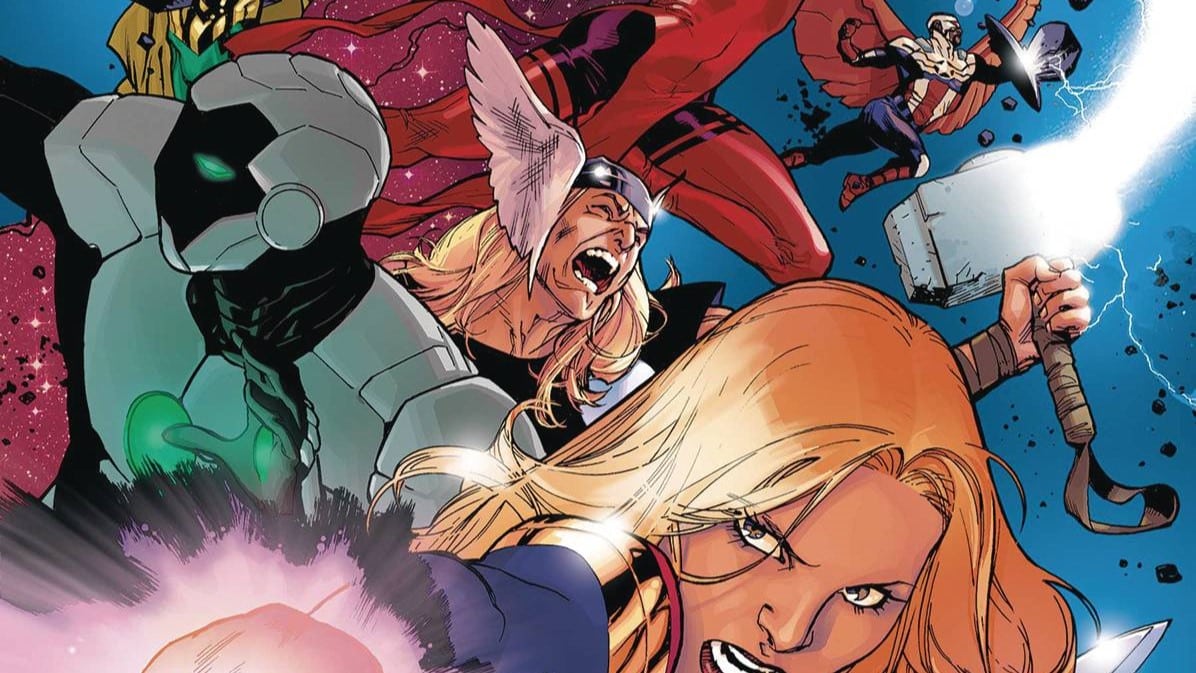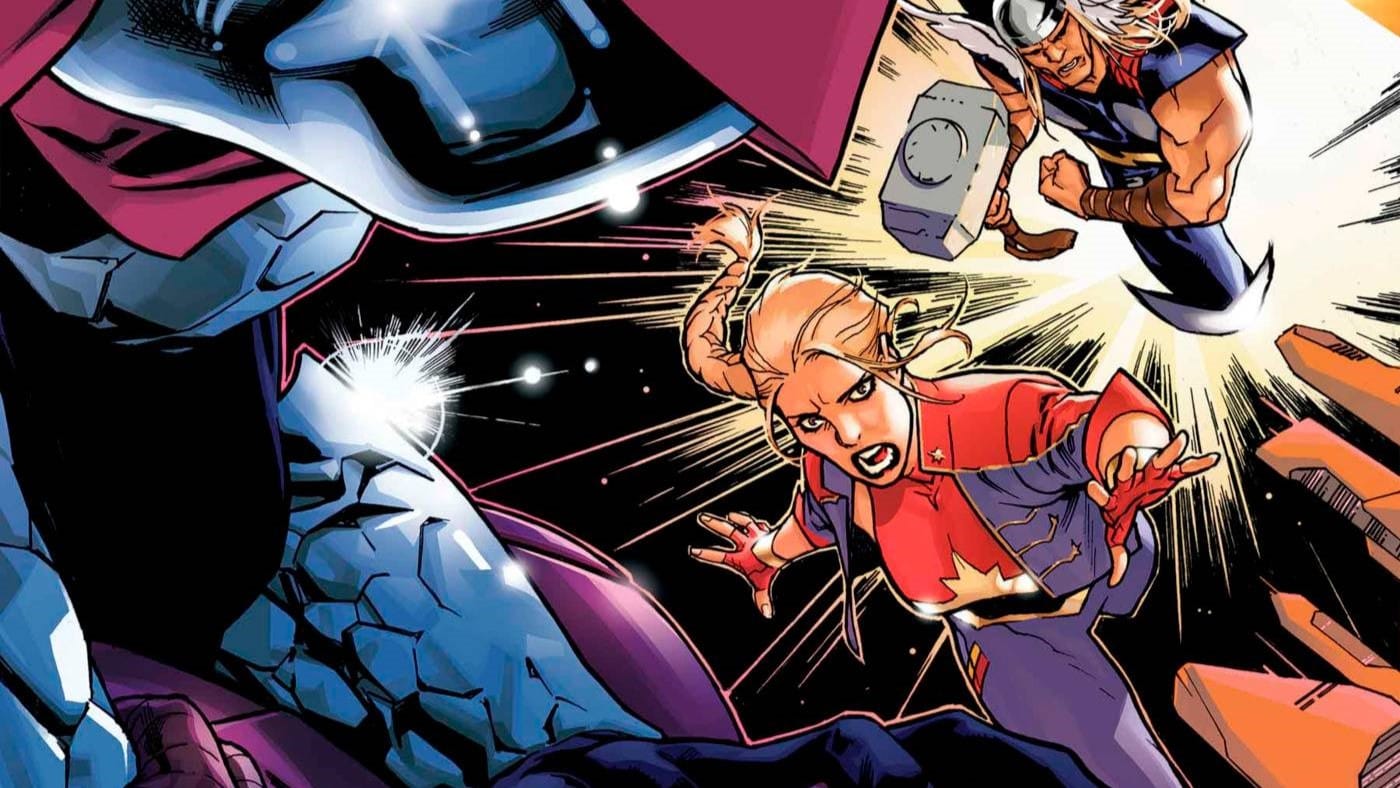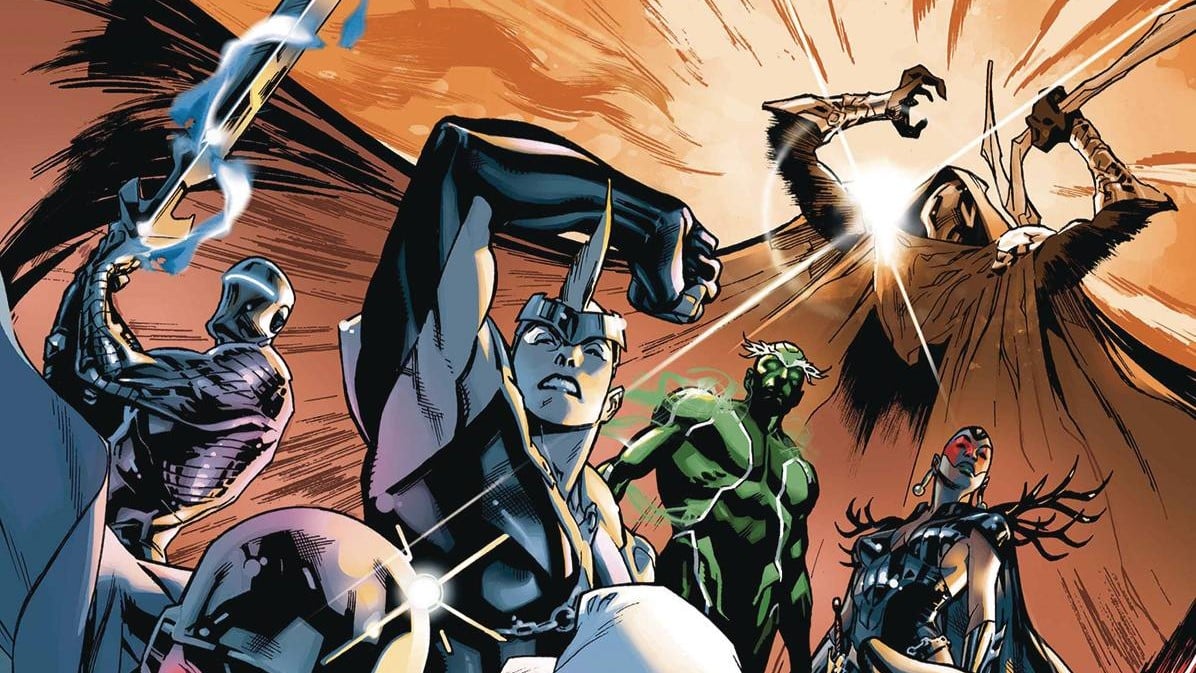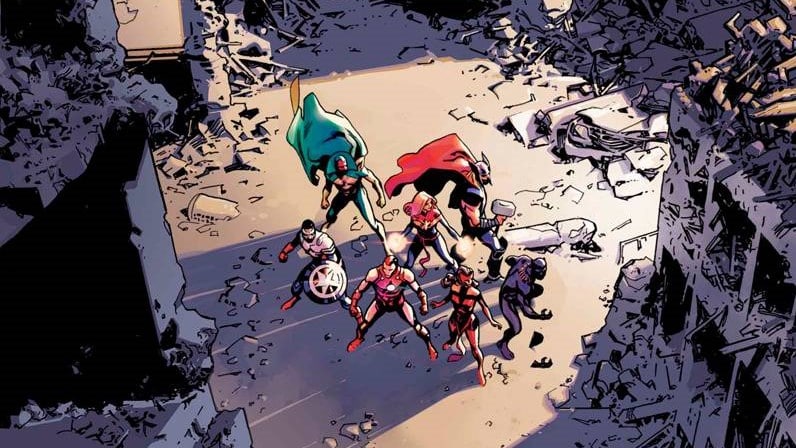The Avengers have been taking a heavy beating from the Ashen Combine. But when all seems lost, and doom seems inevitable, the Avengers rise up with that simplest but most powerful of war cries: “No.” The Avengers #6 written by Jed MacKay, drawn by Ivan Fiorelli, colored by Federico Blee and lettered by Cory Petit.
Anna Peppard: We said we wanted a resolution. And this issue provides that. Sort of. There are still plenty of questions swirling around the Ashen Combine and the Impossible City (aka the newest member of the Avengers??). But the good folks punch the bad folks and do some character development while they’re doing it. There are also smirks and penguins and Carol defeats ennui (the dude and the concept) by using a tanker full of gas to make herself go mini-Phoenix. And I can’t be mad at any of that.
How are you feeling at the end of the arc, Armaan?
Armaan: Simply put, I got what I wanted: a good time. There has been so much set up and fanfare happening I feel like I have been missing out on stuff actually happening, and I got that here in this issue. This feels like a good capper for an introduction, so fingers crossed we’ve got a lot of the set-up out of the way and can really dive into the kinds of things we’ve both been looking forward to about this series!
Set ‘Em Up

Anna: The action of this issue picks up in the immediate wake of the Avengers issuing the Ashen Combine a collective “hell no” at the end of the last issue. It’s a moment we knew was coming (which I still think comes at least an issue too late, but I digress). Like we said in the last review — tropes are what you make of them, and all it all comes down to execution. And the execution here is pretty solid.
It’s not revolutionary; I don’t think anyone who already knows these characters is going to come out of this arc or issue with a radically new understanding of who they are. But it’s on-point and satisfying. We’re reminded of Tony’s ingenuity and forethought. We’re reminded that Wanda’s trauma has taught her as much as it’s tortured her. We’re reminded that Thor is awesome and the Vision is always a wild card, in part because he was created by a fellow synthezoid who definitely wasn’t sane.
Armaan: It’s rare anyone reads an Avengers comic, I think, looking for something revolutionary. What MacKay excels at as a writer is in delivering satisfying character moments. It was perhaps too long in coming, but man, it felt great getting here — like an itch we have been waiting to have scratched for several months now.
I’ll admit that the Ashen Combine arc has felt like reading several individual titles spliced randomly, as opposed to a coherent team book, but in this issue, it really feels like the team’s come together — despite not literally having done so. There’s some cleverness here, some outright displays of power, and some more satisfying human moments, but all of them point to a team that just does not know when to quit.
Anna: Visually, Ivan Fiorelli still isn’t regular artist C.F. Villa. There are some nice individual moments, but the pacing isn’t quite there. He often does this thing that was very popular in the 90s, where you layer panels on top of one another with little to no white space, a technique that can look cool, in theory, but when you’ve got busy panels with lots of lines, machinery, and inhuman characters in them, things can get muddy and confusing in ways that actually slow down the pace of what should be a propulsive fight.
To me it’s a bit of a hallmark of trying too hard, which might relate to the fact that this issue also feels more rushed than the last one; the backgrounds are sparser, and some of the faces are more broadly cartoon-y. This makes me wonder if this series is already beset by scheduling woes. Maybe this storyline was drawn out as long as it was because Villa needed more time?
Anyway — we all know monthly comics is a punishing business, and Fiorelli turns in some very competent work here. But I think some of these moments could have landed a little harder if the art team didn’t have to work quite so hard to land them.
Armaan: Competent work describes it well — though I will say, the larger panels, the spotlight ones, when the art gets the space to breathe? I thought those were great, Carol and Thor’s big moments especially.
Knock ‘Em Down

Anna: I’ve (softly) griped a time or two in these reviews that we haven’t been given as much insight as I would like into MacKay’s specific take on these characters. As discussed above, I think in general, MacKay’s take is pretty standard; these aren’t radical re-envisionings of these iconic characters/iconic brands. But everyone’s still got a take, and up to now, MacKay’s take on much of the cast has been a bit oblique.
This is the most complete picture to this point of who MacKay thinks these heroes are, insight which emerges over the course of each character’s battle against an individual member of the Ashen Combine and specifically, through the techniques they use to defeat their individual foes. Thor and Tony’s moments were fine, but I liked Wanda, Vision, and Carol’s moments best.
Each of these characters uses their smarts to supplement their superpowers. But both Wanda and Vision specifically use smarts steeped in trauma. Wanda can defeat ghosts because she’s met and fought (and will never not be fighting) so many of her own. In a similar vein, Vision can wield corrupt code as a weapon because his own code has always been similarly corrupt. In effect, these characters’ supposed weaknesses get repurposed as strengths, which is exactly the kind of seemingly didactic but actually pretty clever and moving metaphorical stuff the best superhero comics excel at.
Armaan: Wanda’s moment felt like a good extension of what we’ve been seeing in her own solo title. Despite the power she controls — or perhaps because of it — she’s not violent in her response. She’s quick to grasp the rules of what she’s up against, and to turn those rules on her opponents’ heads. Most importantly, though, she still makes room for compassion, promising to help Death somehow, which makes me wonder if there isn’t more going on under that burlap hood of Death’s than we reckoned.
Anna: Carol’s moment is a little different, but still powerfully evokes her history. Every time I see Carol lift a car (or in this case a truck) in a climactic moment, I think of her first superheroic outing. In 1977’s Ms. Marvel #1, she’s established as Marvel’s feminist answer to Superman by aping 1938’s Action Comics #1, hurling a car at the baddies while a little girl stares in open-mouthed awe and tells her mother, “When I grow up—I wanna be just like her!” Carol is the star and she proves it, specifically, by leveraging her passion — the same passion Ennui mocked in the previous issues — as a weapon. She makes Ennui feel everything, which makes him faint (and thank her).
Armaan: She certainly earns her title of the Star, there.
Tony’s moment was interesting to me, as well. It didn’t make me like the character any more (Iron Man: fun comics about a terrible person), but the idea that he’s tuned up his armor to try and mimic powers of his fellow Avengers — seemingly without their permission, as we find out later — is an interesting hook I hope to see played with more down the line. Stark has always been someone who seeks forgiveness rather than asking permission (and rationalizes rather than seeking forgiveness, if he feels he can get away with it). And he’s apparently learned nothing from his mistakes. Or have we all forgotten what happened that time he tried to clone Thor?
You Say You Got a Real Solution

Anna: We conclude with Black Panther and Captain America using explosions to free the Impossible City from bondage, which gives T’Challa an opportunity to say a line that I’m guessing different folks will have different mileage on: “If there is one thing the Black Panther has always known… it is the breaking of chains.” I don’t hate the line, it’s fine.
But given how overdetermined by slavery metaphors Black Panther was for the first couple decades of his existence, in which comic after comic put him in chains inspired by abolitionist imagery that was mostly created by and for white people… I don’t love it. It’s a bit like that moment in the X-Men: First Class movie, where slavery is invoked and they cut to Darwin to underscore it, but all it kind of does is remind you he’s mostly there to make white people feel feelings about his noble suffering (which is subsequently underscored by his nonsensical death shortly thereafter). Anyway… I have enjoyed MacKay’s characterization of T’Challa in general, so maybe just chalk my complaints up to my overly familiar relationship with Silver and Bronze Age tropes.
Speaking of the Bronze Age — the Impossible City joining (?) the Avengers feels like it’s meant to remind us of Vision joining the team in Avengers #58 (1968), and this callback I am here for.
Armaan: This final scene, with the Avengers catching up on the Impossible City with the Ashen Combine all captured made me uneasy — but in a good way. I feel like something’s being set up here. The Impossible City claims that it can’t remember why it had imprisoned the Ashen Combine long ago, before they escaped. The Avengers are a team of heroes who have the Ashen Combine imprisoned on their ship. Is it possible that the Avengers were those heroes from long ago, and that the reason the Impossible City is called that is because it’s caught in a time loop? We know with Kang here, time travel shenanigans are inevitable — but even if this turns out not to be the case, the mystery behind the Impossible City’s origins has me hooked.
Anna: Thoughts on the backup story? I don’t really know why it’s here — will it be ongoing? The writer, Kalinda Vasquez, is mostly known as a writer and TV producer (including for the Runaways show), and previously wrote an America Chavez solo series. The tone is a bit odd to me. The art has a sunny, all-ages feel, but the story, about a little brown girl going missing while no one but her sister (initially) seems to care, is quite dark (albeit also darkly true to life). Unless it’s an ongoing story, the conclusion, where everyone is smiling proudly but the little girl is still missing, hits a bit strangely.
Armaan: The story confused me as well, for all the reasons you mentioned, plus one more: by the end of it, I’m not any closer to understanding who Firebird is, as a superhero or as a character. I’m always glad to see more non-white heroes getting their day on page, but Firebird feels less like someone worth writing a story about and more like someone who just… happened to be there. Replace Firebird with a new character — or even just a civilian — and nothing about this story would change.
If this were a preview for another series, I might have been interested in finding out what happens next, but as a standalone story? It falls flat.
Avengers Assortments!
- Armaan was today years old when I found out that “the sweet science” is a reference to boxing.
- The biggest boon to superheroing they could possibly ask for is being able to knock people unconscious with no other ill effects, as Thor is likely grateful for this issue.
- This Stuart Immomen cover is particularly killer. Any gripes I had about the interior art might be partly chalked up to the unbeatable promise of that cover. Great composition and individual characterization.
- Being the Weezie X-Factor fan that I am, I also saw a callback to X-Factor freeing Ship from Apocalypse then adopting them as their own headquarters in this issue’s Avengers/Impossible City dynamic – Editor Austin.
- The next issue, the start of an arc called “Twilight Dreaming,” is teasing a Vision spotlight — be still my heart!







